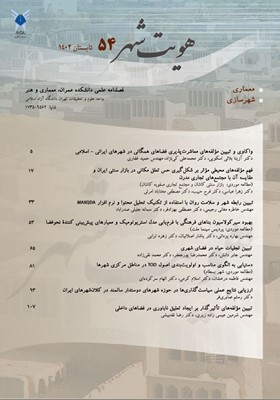ارزیابی نتایج عملی سیاستگذاریها در حوزه شهرهای دوستدار سالمند در کلانشهرهای ایران
محورهای موضوعی : برنامه ریزی شهری
1 - دانشیار گروه جغرافیا و برنامه ریزی شهری، دانشکده علوم اجتماعی، دانشگاه پیام نور، تهران.
کلید واژه: شاخص شهر سالمند, شهرهای دوستدار سالمند, چک لیست استاندارد, کلان شهرهای ایران,
چکیده مقاله :
با رشد جمعیت سالمند، باز طراحی شهرها ضروری شدهاست. این بررسی به روش توصیفی و تحلیلی در این رابطه به انجام رسید. دادهها مورد نیاز در هر دو مقطع 1390 و 1400 با استفاده از چک لیست استاندارد شاخصهای شهر دوستدار سالمند، از نمونهای به حجم 500 نفر از پنج کلانشهر اصلی ایران(تهران، مشهد، اصفهان، شیراز و تبریز) اخذ شد. دادههای گردآمده با استفاده از نرم افزار SPSS و مدلهای چند معیاره مورد تحلیل قرار گرفت. تجزیه و تحلیل دادههای گردآوری شده نشان داد که ضریب محاسبه شده برای شاخصهای شهر دوستدار سالمند کمتر از حد میانه(492/0) است. علاوه بر آن، از سال 1390 تا 1400، میزان ارتقای شاخصهای مورد اشاره کمتر از یک هزازم بودهاست. مقایسه تلاش کلانشهرهای مورد بررسی نشانگر آن است که در این مدت شاخص محاسبه شده برای شهر تهران از 668/0 به 549/0 کاهش پیدا کرده و در همین مدت، شاخص شهر شیراز از 329/0 به 416/0 افزایش یافته است.
Available s tatis tics show that the growth rate of the elderly population has increased. Therefore, policy-making is expected to be in harmony with this trend to realize as many indicators as possible for an elderly-friendly city. The current research was conducted to tes t this assumption. The research method was descriptive and analytical. The required data were collected in 2012 and 2021 using the s tandard checklis t of the indicators of the elderly-friendly city. According to the population, the sample size was determined to be 500 people. The data were collected from five major cities of Iran (Tehran, Mashhad, Isfahan, Shiraz and Tabriz). The collected data were analyzed using SPSS software and multi-criteria models. The data analysis showed that the coefficient calculated for the indicators of the elderly-friendly city is less than the median (0.492). In addition, from 2012 to 2021, the rate of improvement of the mentioned indicators was less than one year. The comparison of the efforts of the examined metropolises shows that during this period, the index calculated for Tehran City decreased from 0.668 to 0.549. In the same period, the index of Shiraz City increased from 0.329 to 0.416. Nevertheless, although it faced a sharp decline in 2021, it is s till in firs t place. Therefore, in this survey, Tehran City showed a better situation in mos t of the indicators than other big cities under inves tigation. According to the findings, in both periods and in mos t cities, the wors t conditions were assigned to the condition of the space and buildings index. In general, the s tatus of the transportation index, except for Tehran City, has gone through a growing trend in mos t of the metropolises. One of the reasons for this is that in recent years, the operation and development of urban trains in these cities have brought about extensive changes in the field of transportation. In the classification in terms of the total score, it was found that in 2012, Tehran City was in the firs t place, and Isfahan and Mashhad were in the second and third place, respectively, with a big difference. This year, Shiraz City has taken the las t place. In 2021, Isfahan City was ranked the highes t, followed by Tehran City in the second rank and Mashhad City in the third rank, with a not-too-big difference. In this year, Shiraz City has moved up to the fourth place by one rank, and Tabriz City is in the las t spot after Shiraz City with a minimal difference. According to the calculated scores, in 2012, only three cities - Tehran, Isfahan and Mashhad - had a score higher than 0.50. Therefore, these cities show more proportionality with the positive ideal level. Meanwhile, the situation of the two cities of Tabriz and Shiraz Cities in this year, due to the fact that they are far away from the ideal level, are not very favorable. In 2021, this situation remained almos t unchanged, and Tabriz and Shiraz Cities were s till far away from the ideal level.
ageing. 28 (3),116-21. https://doi.org/10.1111/j.1741-6612.2009.00355.x
_||_


